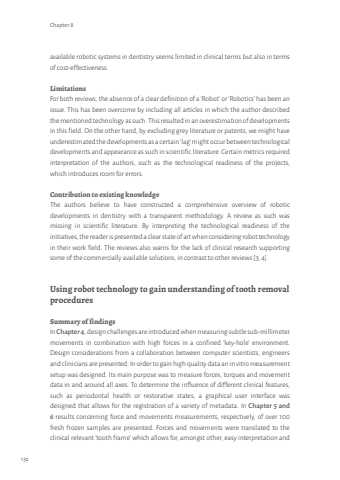Page 134 - Demo
P. 134
Chapter 8132available robotic systems in dentistry seems limited in clinical terms but also in terms of cost-effectiveness. LimitationsFor both reviews, the absence of a clear definition of a ‘Robot’ or ‘Robotics’ has been an issue. This has been overcome by including all articles in which the author described the mentioned technology as such. This resulted in an overestimation of developments in this field. On the other hand, by excluding grey literature or patents, we might have underestimated the developments as a certain ‘lag’ might occur between technological developments and appearance as such in scientific literature. Certain metrics required interpretation of the authors, such as the technological readiness of the projects, which introduces room for errors. Contribution to existing knowledgeThe authors believe to have constructed a comprehensive overview of robotic developments in dentistry with a transparent methodology. A review as such was missing in scientific literature. By interpreting the technological readiness of the initiatives, the reader is presented a clear state of art when considering robot technology in their work field. The reviews also warns for the lack of clinical research supporting some of the commercially available solutions, in contrast to other reviews [3, 4]. Using robot technology to gain understanding of tooth removal proceduresSummary of findingsIn Chapter 4, design challenges are introduced when measuring subtle sub-millimeter movements in combination with high forces in a confined ‘key-hole’ environment. Design considerations from a collaboration between computer scientists, engineers and clinicians are presented. In order to gain high quality data an in vitro measurement setup was designed. Its main purpose was to measure forces, torques and movement data in and around all axes. To determine the influence of different clinical features, such as periodontal health or restorative states, a graphical user interface was designed that allows for the registration of a variety of metadata. In Chapter 5 and 6 results concerning force and movements measurements, respectively, of over 100 fresh frozen samples are presented. Forces and movements were translated to the clinical relevant ‘tooth frame’ which allows for, amongst other, easy interpretation and Tom van Riet.indd 132 26-10-2023 11:59


